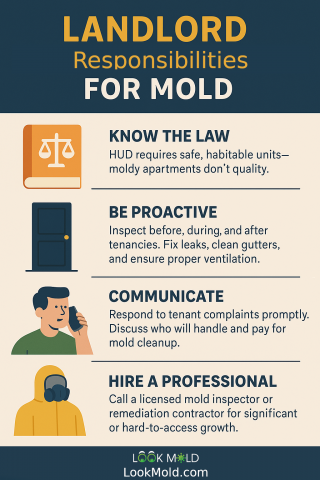Professional Mold Remediation Services
Don't Let Toxic Mold Put Your Family's Health at Risk
Stop mold damage before it spreads. Call now for a free, no-obligation estimate from a local remediation expert.
Free Estimate · Zero Obligation · Available 24/7
Landlord Responsibilities for Mold
Let’s get real — if you’re a landlord and your tenant just told you there’s a musty smell, black spots on the ceiling, or a leak that’s been ignored for too long, you’re officially on the clock.
As a licensed mold assessor, I’ve worked with plenty of property owners — good ones and not-so-good ones. The difference? The good ones take mold seriously before it becomes a lawsuit.
This guide is for landlords who want to understand their responsibility, do the right thing, and avoid legal and financial headaches.

🧾 Are Landlords Legally Responsible for Mold?
Short answer: Yes, usually.
There’s no federal mold law, but most states require landlords to provide a “habitable” living space — that means safe, clean, and free from conditions that harm a tenant’s health. Mold? It’s at the top of that list.
According to HUD, moisture control and prompt repairs are essential parts of landlord maintenance duties.
In most states, if mold develops because of a leak, flood, or ventilation issue — and the tenant didn’t cause it — you’re on the hook to fix it.
If you ignore it?
- Your tenant can withhold rent
- Break the lease early
- Sue for damages
Check your state’s landlord-tenant laws, but mold complaints can escalate fast. For more on how mold becomes a legal and health issue, read Black Mold: What It Is and How It Affects Your Home.
🛠️ What Causes Mold in Rental Properties?
Mold doesn’t just appear out of nowhere — it shows up when moisture sticks around.
Common causes:
- Leaking pipes or faucets
- Poor ventilation in bathrooms or kitchens
- Roof leaks or clogged gutters
- Water damage from floods or burst pipes
- Damp basements or crawl spaces
According to the EPA, mold can grow in as little as 24 to 48 hours after a water event.
The best way to prevent mold? Control moisture before it becomes mold. Learn more in our guide on How Mold Grows Indoors.
🔍 How to Respond to a Mold Complaint
If a tenant says there’s mold, don’t brush it off. Here’s how to handle it like a pro:
Step 1: Investigate Promptly
- Ask for photos and a written description
- Inspect the area within 24–48 hours
- Check for visible mold, water stains, or musty smells
Step 2: Fix the Moisture Source
- This is non-negotiable. Mold will keep coming back if moisture isn’t addressed.
Step 3: Clean or Remediate
- Small surface mold on hard surfaces? You or a handyman might handle it.
- Mold on drywall, subflooring, insulation, or from leaks? Call a licensed mold remediation pro.
The EPA recommends hiring professionals if the area is larger than 10 square feet or if HVAC is involved.
Step 4: Communicate Clearly
- Let the tenant know what’s being done and when
- Provide written updates or documentation if needed
🧑⚖️ Can Tenants Sue Over Mold?
Yes — and they do.
If mold makes a tenant sick or damages their belongings, and you didn’t act reasonably or quickly, you could be liable. In some states, tenants have won lawsuits for:
- Medical bills
- Hotel stays during repairs
- Mold-damaged furniture and clothing
- Emotional distress
Even if they don’t sue, they could file complaints with:
- Local housing authorities
- HUD (for subsidized housing)
- The Consumer Financial Protection Bureau
📝 How to Protect Yourself as a Landlord
Here’s how to stay ahead of mold problems:
- Respond to all water damage issues within 24–48 hours
- Document all repairs and tenant communications
- Schedule regular inspections (especially in basements, attics, and bathrooms)
- Install bathroom exhaust fans and dehumidifiers where needed
- Educate tenants on ventilation, moisture control, and reporting leaks early
HUD guidelines recommend clear mold policies in rental agreements and lease disclosures.
📋 Should You Test for Mold?
If there’s visible mold and a known water issue — no, you don’t need to test. You need to fix it.
But if:
- You suspect mold behind walls
- Tenants report health issues
- You need documentation for insurance or legal protection
Then yes — get a licensed mold inspector. Testing provides a written report, identifies species, and helps confirm successful remediation. Here's what to expect during a professional mold inspection.
🧠 Final Thoughts
As a landlord, you’re not expected to be a mold expert. But you are expected to take action — fast, thorough, and documented.
Fix leaks quickly. Communicate clearly. And when in doubt? Bring in a pro.
Because here’s the truth: mold doesn’t just damage buildings. It damages trust, tenancies, and reputations. If you're unsure what kind of mold you're dealing with, check out our mold type guide.
Got questions or need a mold inspection? Schedule a mold assessment from a licensed pro who knows how to handle rental property cases.
Sources:
HUD - Mold in Housing
HUD HCV Landlord Guidebook - Inspections
EPA - Mold Cleanup Guidelines
EPA - General Mold Info
EPA - Contact About Mold
Consumer Finance - Renters Rights
FTC - Rental Listing Scams
Explore Related Topics:
Notice an update we should make?
We strive for accuracy. Contact us here if you see incorrect or outdated info on this page.
